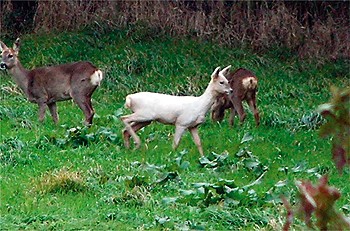Roe Deer – A rare sight

In February 2004, the pages of Shooting Times carried an account of a white fallow doe, leading me to fulfil my winter cull target (Camping for fallow, 5 February 2004). I had been camped out on the ground for two days already and had seen neither hide nor hair of the deer population I was supposed to manage. It was my final day, and my spirits were at a low ebb as I crossed a ploughed field towards a small copse. Through the rainstorm, I glassed the edge of the main wood in the distance only to pick out a solitary sheep and no deer. Ten paces on and I stopped in my tracks ? there were no sheep on this ground, and a less perfunctory inspection through binoculars identified the white animal as a fallow doe. Behind it was a group of around 20 does and yearlings. The rest, as they say, is history, but I reached my cull target of three does about an hour later.
White fallow are a reasonably common colour variation of the species, but this is not so for roe deer. The white roebuck in Scotland drew much media attention a year or so ago, and many lowland stalkers have never seen such a rarity. I relate the tale of my encounter with the white fallow doe because a similar case of mistaken identity arose last year. This time it was not through a pair of wet binoculars in a rainy Lincolnshire landscape, but from the comfort of my study at home. Working at my computer on some complicated spreadsheet, I lifted my eyes from the screen to glance out of the window and noticed that there was a sheep grazing the field behind the house. Returning to the spreadsheet, the thought again hit me ? my neighbouring farmer does not have sheep.
One of a kind
With a creeping feeling of déjà vu, I turned to the window again while reaching for the camera. There, barely 80 yards from my study, was one of the most unusual animals in Britain ? a white roe doe. We had often seen deer in the back field. The regular residents were a family party of four normal- oloured roe, and occasionally, a young buck made an appearance, but the animal I was now watching was different. Close inspection through my spotting scope showed that this was probably not an albino as she had a black nose and normal- coloured eyes and, far from being ostracised by her species, she was very much part of another family group of three that I had not seen before.
I emailed the images to friends who have far more stalking experience than me, and Jan Andrews, John Dryden and Paul Atkins all replied in the negative ? they had never seen such an animal. Throughout the year that we lived in the cottage, she regularly put in an appearance in the field beyond the garden, and word from our old neighbours is that she is still there ? probably the only white roe deer in Somerset.








